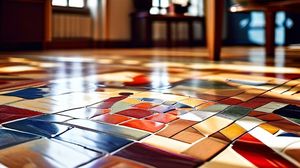
Little Holland House in Carshalton presents a fascinating glimpse into the Arts and Crafts movement, being the creation of Frank Reginald Dickinson, an architect who ensured that every aspect of the house reflected his unique vision. Built between 1902 and 1904, the house was entirely hand-crafted by Dickinson himself, showcasing his dedication and skill.
The house features original interior designs, including hand-painted murals and individually designed furniture, which offer visitors a rare opportunity to experience an authentic Arts and Crafts environment. It's a testament to the era's philosophy that the boundaries between fine and applied arts should be blurred.
Little Holland House is renowned for its careful attention to detail and the way it integrates art into daily life. Visitors are often surprised by the small size of the house compared to the expanse of detail and craftsmanship within, making it a place of intriguing contradictions.
An intriguing feature of the house is how Dickinson took inspiration from figures like William Morris and John Ruskin, while infusing his own personality throughout. Each room reveals a part of his character and worldview, expressed through art and architecture.
Uniquely, the house remained in the Dickinson family until the late 1970s, ensuring that much of its original character and contents were preserved. This makes it an exceptionally authentic historical site.
Due to its meticulous craftsmanship and historical significance, Little Holland House is not only a showcase of Dickinson's artistic talents but also a splendid example of the commitment to artistic integrity seen in the Arts and Crafts movement, making it an outstanding cultural asset.

Making the Most of Your Visit:
If you're visiting Little Holland House, make sure to take your time in each room. It's small and intimate, which means you can really soak in all the details that make the place special. Pay particular attention to the murals; each one tells its own story and shows Frank Dickinson's skill as both an architect and an artist.
Look at the furniture closely. Unlike in many historical homes, you're encouraged to notice how each piece was designed to complement the others and the house itself. Dickinson personally crafted these, and every curve and finish has a purpose which ties into the larger aesthetic vision.
Visit when there's a guided tour if you can, as they are sometimes available and led by local historians. They often provide insights you might miss on a self-guided experience, especially regarding Dickinson's inspirations and the Arts and Crafts philosophy.
Spend some time considering the views from the windows. Dickinson was known to consider the garden and surrounding views as extensions of the house itself, so what you see through the glass was intentionally curated as well.
Lastly, engage with the house's environment. The surrounding area of Carshalton is rich in history and nature, and the ambiance can truly enhance your visit, especially if you're interested in seeing how the Arts and Crafts movement integrated with daily life beyond architecture and interior design.

Visiting Times & Costs:
Little Holland House in Carshalton is open to the public, but it operates under specific conditions. It is typically open on the first Sunday of each month, offering a unique opportunity to explore this historic site. Check in advance for any changes to this schedule due to special events or maintenance.
Entry is free, making it an accessible cultural experience for all visitors. As it is a small, historic house, there may be some limitations regarding accessibility for those with mobility challenges. Visitors should be prepared for the possibility of narrow doorways and limited wheelchair access.
It is advisable to check current visiting hours and any additional access arrangements that might be in place before planning your visit.

Address & Map:

Nearby:

